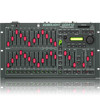Behringer EUROLIGHT LC2412 Manual - Page 9
°5°, Control elements of the programming, Control elements of the main - dmx lighting console
 |
View all Behringer EUROLIGHT LC2412 manuals
Add to My Manuals
Save this manual to your list of manuals |
Page 9 highlights
9 EUROLIGHT LC2412 User Manual Example: You have disabled the solo function for channel 8. The light on channel 8 remains lit if you press one of the Flash keys, as long as the solo function is active. Previously, you have programmed a memory that uses channel 8. The memory has just been activated on the stage. Now, press one of the Flash keys (CH FLASH (32) is also activated). There are two lights on the stage, i.e. channel 8 and the channel activated with the key! 2.5 Control elements of the programming section ( 5 ) Despite its compact size, the EUROLIGHT LC2412 is a versatile light mixing console. In it, we have integrated a plethora of functions, among others, various functions for memories, chases and digital control. The basic elements of the programming section are located at the top right section of the unit. To let you quickly orient yourself in difficult situations, the LC2412 also features a display. (25) (26) (27) (28) (29) (24) (30) (31) (32) (33) (34) (36) (35) (37) (38) Fig. 2.6: The programming section (39) (40) (24) PCMCIA CARD slot. This interface accepts the memory card on which you can store your console setups. (25) MEMORY key. By pressing the MEMORY key once, you initiate the procedure that saves a stage scene. How this procedure functions in particular is explained in greater detail in chapter 4.1. (26) CHASE key. Used to initiate the programming procedure (intended for creating a chase). How this is done is explained in chapter 6.1. (27) The CTM key (stands for chase to memory) brings up the menu for storing chases. Basically, you can store completely programmed chases into memory. Each of the ten memory banks has four memory slots (9 - 12) available for this purpose. (28) UTILITY 1. This key takes you to the following programming menus: DISABLE SOLO, SELECT CURVE and THEATRE MODE. (29) UTILITY 2. This key takes you to the following programming menus: DMX PATCH, SELECT MIDI and SELECT SPECIAL. Further information about these functions is to be found in chapters 7 and 8, "ADDITIONAL FUNCTIONS OF THE LC2412" and "DIMMER CONTROL". (30) LIVE key. By pressing this key, you can route chase or memory steps to the console's output in order to see what it would all really look like on the stage. This also makes sense for the programming procedure itself, because chases are for example only shown on the LEDs during their selection (normal setting, blind mode). This way, selecting chases is even possible while a program is running on the stage, without disrupting the program itself (automatic preview). The live mode changes everything the other way around: only the settings observed in the preview function are visible on the stage. (31) SOLO. The solo function utilizes the flash keys. When the solo function is active, pressing the FLASH key for a single channel/memory completely dimms all other lights. If so desired, individual channels can be taken out of the solo function's reach (see chapters 4.3.1 and 2.4.1). (32) CH FLASH key. Switches the channel flash function on and off. When the channel flash function is on, you can use the FLASH keys ((22) + (23)) to enable the highest illumination level on individual channels. This function is automatically activated in preset mode (see chapter 3.1.1). However, it has to be manually activated in memory mode. (33) UPPER switch. Used to switch over to channels 13 - 24. See also chapters 2.1 and 3.2. (34) CONTRAST control. Turning this pot lets you adjust the display contrast. (35) PROGRAM display. Depending on the programming procedure, different menues are shown here. If you haven't programmed anything yet, or if you have quit a programming procedure by means of pressing the QUIT key (40), the display shows the current chase and the respective step (basic setup). (36) DATA wheel. Used to change/select programming parameters. For example, it can be used for programming chases, during which you dial in steps and determine their execution speed. Besides, it is also used for directly calling up chases (see also chapter 6.2). (37) SHIFT key. Opens additional programming menues. A more detailed explanation can be found in the description of the respective programming procedures. (38) SOFT A key. Needed for selecting items while in a programming menu. The menu texts and the SOFT A key are ordered in such a way that this key lets you select the options above (appearing in the menu). (39) SOFT B key. Has the same function as the SOFT A key. (40) QUIT key. Used for closing a programming procedure and going back to the main menu. 2.6 Control elements of the main section ( 6 ) (41) (42) (43) (44) (45) (45) (47) Fig. 2.7: The main section Control elements that apply to function groups or the entire console are grouped in the main section. (41) A fader. This fader is the master fader for the A PRESET section; it determines the maximum illumination level of the entire section. The FLASH keys ((22) / (23) as well as (44) / (45)) can still be utilized, even when the fader is at its zero position.















